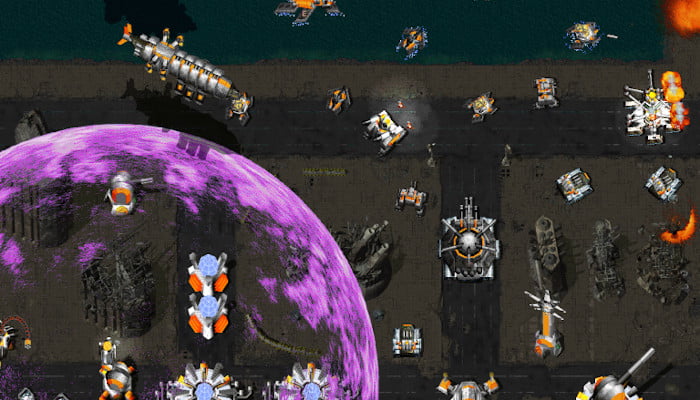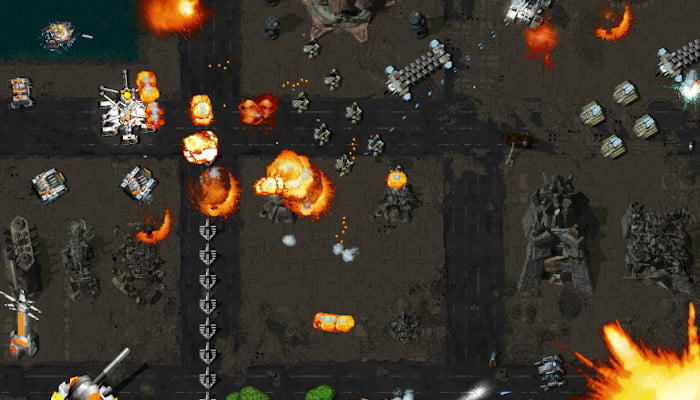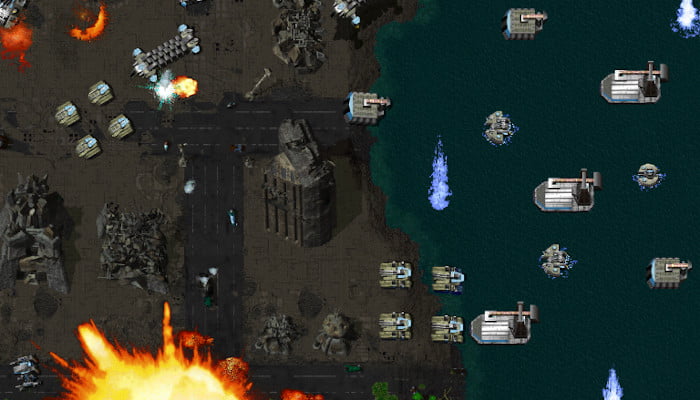Generally speaking, I am ‘good’ at games I care about. I can play first-person shooters, platformers, exploration games, card games, and in most cases, I am aware of how those games play, and I as an adult, have become better at those games over time. It is, in general, not the case that a game I care about is a game that I know I am terrible at playing.
But real time strategy games?
I am dire.
Which is a bit of a problem when you consider how many hours of my life have been spent playing the various different iterations on the formula that started for me with Dune II and Warcraft: Orcs Vs Humans. It’s a model of gameplay that I felt was perfected in the late 90s not by Starcraft but by the dueling Australian releases of Auran’s Dark Reign and Cave Dog’s Total Annihilation. These two games were months of my childhood afternoons — and I am absolutely abysmal at playing both.

Total Annihilation is a game from 1997 which used the finest of mouse interfaces to put you, the player, in direct command of a super-tech military force represented by blocky robots, blocky tanks, blocky planes, and blocky boats, as you built buildings to give you resources, other buildings to give those other buildings resources, and other other buildings to make more of those blocky robots tanks planes boats and hovercraft, there are hovercraft now, keep up.
The story of Total Annihilation is weird mix of utopian technologism and absolutely dystopic humanity. See, in this world, humanity has spread across the galaxy, and colonised most of the space in the Milky Way. Eventually, a coalition of humans and AI at the centre of the world, known as the CORE successfully develop the technology to let people turn themselves into code, a process called Patterning. Since this represented a sudden and immense 100% life expectancy and all-purpose everything vaccine, they made this process mandatory, which a bunch of people who liked being made out of meat and don’t like simulating the experience refused to do. Okay, so it’s a fascist dictatorship demanding people give up their freedoms, so far so good.
But then these rebels, to match pace with the fascist dictatorship that could ctrl-c ctrl-v all their best military combatants, decided what they needed to do was mass human cloning farms, which would allow them to keep pace and just, you know, throw more people into the murder machine, so suddenly the moral superiority goes out the window there.
One weird bit of trivia about this game is that it’s Australian, with Cavedog, the company that made it, being based out of Adelaide, to contrast with Krush Kill N Destroy‘s Melbourne House and Queensland’s Auran that made Dark Reign (and yeah, give it time, I’ll get there). Except, despite me repeating this story for years, it turns out that I’ve been wrong the whole time, and Cavedog are from Washington, and yet I’ve never been corrected on this. I’m only bringing it up here so that if I go back and search it later, this correction is here. Hi, welcome to being part of my notepad.
What set the game apart from its cousins in the space was a combination of its use of 3d models instead of individual sprites which allowed for things like deformation of terrain and line of sight over very large distances, and the game’s absolutely crackerjack scale. Even games like Command & Conquer, which meant to replicate real world military materiel had to do it in a kind of babby-mode sandbox, where the biggest and most impressive of tanks still could only shoot a shell maybe four or five times their length away. By comparison, the Bradley Fighting Vehicle, which I have been assured is a thing that exists has missiles that can fire four kilometers in the real world.
Total Annihilation doesn’t get scale ‘right’ in that way, per se, but it did ramp things up just by dint of having units that were capable of firing outside of their direct line of sight. If you could target a space, by say, having a scouting airplane flying over it occasionally, you could have an artillery vehicle fire at that spot from over a hill. The animation of these things was also a cut above, even if in a very pantomine way. Your robots were a kind of infantry, and mostly could interface with one another on the personal level. Vehicles, like tanks, would often be able to do more, but bigger and slower, meaning supporting them with smaller robot helped them survive. Also, planes could do spotting or softening things up for the tanks, and then there were planes for protecting your planes that were there to do spotting and the whole system has to be balanced in real time, depending on what strategy you want to do.
This scope also meant that maps could be enormous. The biggest maps in Warcraft 2, one of the contemporary success stories of the era, were smaller than the medium sized maps in Total Annihilation, and when the modding scene came along and found that there weren’t really meaningful limits on them, Total Annihilation maps got to be gonzo big. Which was good, because there were weapons you could build in Total Annihilation that seemed to have ‘unlimited range,’ but what they had instead was ‘range in kilometers,’ and it was entirely possible you’d need them.
This scope and scale, coupled with the game’s immense mental load, meant that turtling was a strategy that if not successful was solid. A notable gameplay gear is how in a lot of other games like Warcraft and Command & Conquer, resources were limited, even if they were vast; gold mines collapsed, tiberium fields depleted, which meant that you could turtle up for a time, you could build up, but you could never do it forever, because eventually you hit the game’s build limit, eventually you ran out of resources, eventually you had to use the stockpiled materiel to go do something.
Total Annihilation‘s game fiction wasn’t like that. Power came from wind, air, and yes, okay, some nuclear power (which went boom real good if it was destroyed in the field). Your metal, the thing you built robots out of, came from high-tech mines that dug into the earth and went deep, which meant that they were unlimited in the scope of a human interaction. Also the unit cap wasn’t stated. You could build units and if your economy supported building them that was it. Your computer could maybe get overloaded if you built, you know, a few hundred, but there was no limit on that that stopped you doing it.
The end game of Total Annihilation games was often two enormous economic engines building multiple gun emplacements that would be in any other game the single campaign-ending tool and shelling corners of the map at random with explosions a few hundred meters across just in the name of softening them up. The only thing the game asked of you to get to this point was time, and, well, not taking a more aggressive stance.
Describing the type of game Total Annihilation is comical as if the biggest games in the world don’t look exactly like it, just a much more refined version. But while industry leaders League of Legends and Defense of the Ancients are the refined processed penicillin of a civilised culture, and Dune II is spitting on a wound and hoping, Total Annihilation is more akin to bloodletting, a task that clearly understands that this stuff is important but not necessarily working out how. It sits on a threshold somewhere after a bunch of interface problems were fixed, but still at a point in the genre’s evolution where we hadn’t locked down what made these games generally engaging.
And make no mistake, Total Annihilation was fantastically engaging. I would spend hours playing the game and maybe finish one map. Maybe. There’s a type of player who revels in this kind of game, where the idea of being able to build up to these huge battles, even if things don’t work out well for you, is important and waiting literally an hour to get there is not seen as a dealbreaker. You can see that in the games that have come in Total Annihilation’s wake, Supreme Commander and its ilk, where the games have just made more and bigger versions of what Total Annihilation was doing.
As for myself, when it comes to these 90s real-time strategy games, despite having tons of experience and familiarity with all the units, it’s because rather than playing campaigns or player-versus-player stuff, I played the game in a skirmish mode, and then either used cheat codes or, in the case of Total Annihilation, a game exploit to immobilise the computer player, then just… built. I just built. I built big elaborate bases and made them aesthetically pleasant and made them symmetrical or just explored the tech tree. When I ran out of tech tree, when I got bored of my bases on these maps, I moved on to mods, and downloaded them and expanded the tech tree with new, incredibly interesting ideas added like repair towers and the aforementioned hovercraft and a festival of interesting, specific tactical options.
The armies weren’t symmetrical, either. They were close, but they just didn’t quite line up perfectly. That meant that if you wanted to play with the enormous megaweapon that was the CORE army Krogoth, you didn’t have a clear alternative choice in the ARM forces, but if you wanted to play around with swarms of Mavericks and stealth tools, you had to go to ARM for them.
When presented with a game with a conflict system in it, I tipped all the pieces off the board and played around with the pieces. I wanted to make my own units, too – I know I explored it, but my exploration took me to other games.
I have sunk enormous amounts of time into playing this game and I think I’ve maybe successfully won three or four ‘games’ against the AI where I make armies and units and attack my enemy and oppose their attacking mine. This is one of my favourite games from this era, and if you asked me how to win a game of it I would have literally no idea how to answer you. It’s not like The Swindle, where I am expert at its execution, or Baldur’s Gate 2, where my head is full of thousands of small tricks, even if I don’t really know how the game expects you to be ‘good’ at it.
I played it for hours, hours, days in aggregate, and maybe, in my heart of heart, I felt bad about not being able to play the game ‘right.’ I know trying to play the game to win the campaign was too difficult for me; I kept getting interested in the cool things the buildings could do, the integrated way that systems worked, the ways you could make a space ‘completely safe’ from an AI. And not for a moment long enough that it stands in my memory as meaningful did I play Total Annihilation the way that the game ‘should’ be played.
I played this game ‘wrong.’
There is no wrong way to play.



1 Trackback